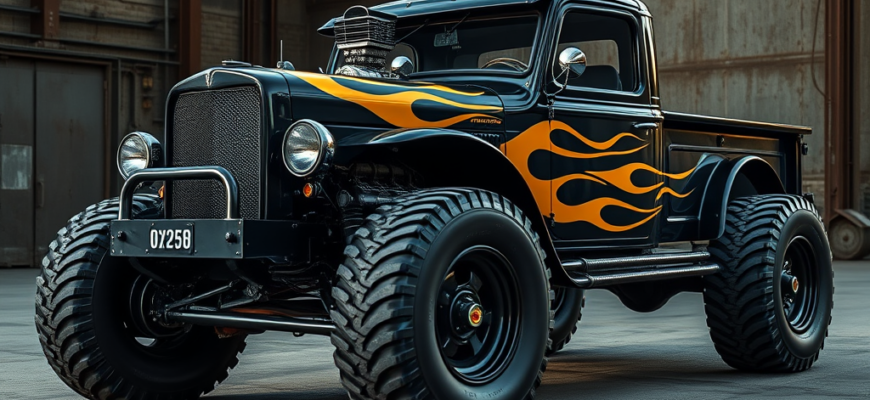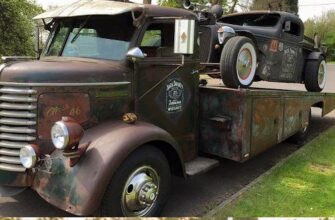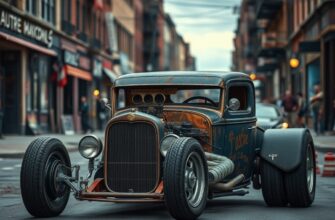The automotive landscape is a diverse tapestry, woven with threads of gleaming chrome, aerodynamic curves, and the roar of finely tuned engines. Yet, within this vibrant scene exists a counter-movement, a rebellion against pristine perfection – the rat rod revival. More than just modified vehicles, rat rods embody a defiant spirit, a celebration of raw authenticity, and a nostalgic nod to the early days of hot-rodding. This article will explore the history, ethos, benefits, and potential pitfalls of this captivating subculture, offering insights into how one might embrace this untamed automotive philosophy.
- The Genesis of Grit: A Look at Rat Rod History
- The Allure of Authenticity: Exploring the Benefits of the Rat Rod Philosophy
- Navigating the Rough Edges: Potential Drawbacks and Risks
- Embracing the Grit: How to Appreciate the Rat Rod Aesthetic
- Tips for Those Drawn to the Untamed: Entering the Rat Rod World
- Conclusion: The Enduring Appeal of Rust and Rebellion
The Genesis of Grit: A Look at Rat Rod History
To understand the rat rod revival, one must first journey back to the roots of hot-rodding itself. In the post-World War II era, young American servicemen, armed with mechanical skills and a thirst for speed, began modifying pre-war Ford Model Ts, As, and Bs. These early hot rods were often built with whatever parts were available, prioritizing function and performance over aesthetics. They were raw, utilitarian machines, born from ingenuity and a desire to push the boundaries of speed.
As hot-rodding matured, a parallel trend emerged. While some enthusiasts pursued increasingly polished and show-worthy vehicles, others retained the stripped-down, no-nonsense approach of the early days. These were the precursors to the modern rat rod. They were the “unrestored” hot rods, often left in their weathered state, bearing the scars of time and use.
The term “rat rod” itself gained traction in the late 1980s and early 1990s, often used somewhat derisively by traditional hot-rodders to describe these rough-around-the-edges creations. However, a shift began to occur. A new generation of builders and enthusiasts, disillusioned with the high costs and often sterile perfection of mainstream hot-rodding, started to embrace the raw aesthetic and rebellious spirit of these “ratty” machines. They saw beauty in the patina, character in the exposed mechanicals, and a refreshing authenticity in their unpretentious nature. This marked the true beginning of the rat rod revival movement.

The Allure of Authenticity: Exploring the Benefits of the Rat Rod Philosophy
The resurgence of rat rods is fueled by a compelling set of benefits that resonate with a growing number of automotive enthusiasts:
- Cost-Effectiveness: Compared to meticulously restored or highly customized traditional hot rods, rat rods can often be built or acquired at a significantly lower cost. The emphasis on using readily available or salvaged parts, and the acceptance (even celebration) of existing wear and tear, reduces the financial burden of entry into the classic car world.
- Uniqueness and Individuality: Each rat rod is a unique expression of its builder’s vision and resourcefulness. The lack of strict rules or adherence to a specific restoration guide fosters creativity and allows for highly personalized vehicles that stand out from the crowd.
- Accessibility and Inclusivity: The rat rod scene tends to be more inclusive and less focused on concours-level perfection. It welcomes those with limited budgets and encourages a “do-it-yourself” ethos, fostering a strong sense of community and shared passion.
- Historical Connection: Rat rods often retain a tangible link to automotive history. The visible patina, original components, and sometimes even period-correct modifications offer a glimpse into the past and the evolution of hot-rodding.
- Function Over Form (Primarily): While aesthetics are undoubtedly a part of the rat rod appeal, the underlying principle often prioritizes functionality and the driving experience. These machines are meant to be driven and enjoyed, not just admired in a garage.
- Rebellion Against Conformity: In a world often obsessed with flawless presentation, rat rods stand as a defiant statement against the pressure to conform. They celebrate imperfection and embrace a more rugged, untamed aesthetic.
Navigating the Rough Edges: Potential Drawbacks and Risks
While the rat rod movement offers numerous attractions, it’s essential to acknowledge potential drawbacks and risks:
- Safety Considerations: The emphasis on raw aesthetics can sometimes lead to compromises in safety. Exposed sharp edges, unreliable or outdated mechanical components, and a lack of modern safety features can pose risks if not addressed thoughtfully.
- Legality and Roadworthiness: Depending on local regulations, heavily modified vehicles, especially those incorporating unconventional parts or lacking certain safety features, may face challenges in terms of registration and roadworthiness.
- Reliability: While the focus is often on functionality, the use of older or salvaged parts can sometimes lead to reliability issues. Regular maintenance and a thorough understanding of the vehicle’s mechanics are crucial.
- Public Perception: The unconventional appearance of rat rods can sometimes draw negative attention or misunderstandings from those unfamiliar with the culture.
- Long-Term Durability: Depending on how the vehicle is built and maintained, the lack of extensive rustproofing or modern protective measures could potentially impact its long-term durability.
- Resale Value (Potentially): While some highly sought-after rat rods can command significant prices, the generally unconventional nature of these vehicles might limit their appeal to a broader market, potentially affecting resale value compared to traditionally restored classics.
Embracing the Grit: How to Appreciate the Rat Rod Aesthetic
For those intrigued by the rat rod movement, understanding and appreciating its unique aesthetic is key. It’s not simply about neglecting a restoration; it’s about a deliberate choice to celebrate the history and raw character of a vehicle. Here’s a guide to developing an appreciation for the rat rod style:
- Look Beyond the Surface: Focus on the story the vehicle tells. The patina, the dents, and the mismatched parts are all testaments to its past and its journey.
- Understand the Intent: Recognize that many rat rods are built with a specific vision in mind, often drawing inspiration from early hot-rodding and a desire for unfiltered authenticity.
- Appreciate the Ingenuity: Notice the creative solutions and resourceful use of parts. Rat rods often showcase the builder’s mechanical skills and ability to make disparate components work together.
- Consider the Functionality: While aesthetics are important, remember that many rat rods are built to be driven and enjoyed. The focus is often on a raw, visceral driving experience.
- Engage with the Culture: Attend rat rod gatherings and connect with enthusiasts. Understanding the passion and camaraderie within the community can deepen your appreciation for the movement.
Tips for Those Drawn to the Untamed: Entering the Rat Rod World
For those feeling the pull of the rat rod revival and considering embarking on their own project or acquiring an existing build, here are some essential tips:
- Prioritize Safety: While embracing the raw aesthetic, never compromise on essential safety features. Ensure brakes, steering, and suspension are sound. Address any significant structural rust that could compromise the vehicle’s integrity.
- Know Your Local Regulations: Research and understand the vehicle registration and roadworthiness requirements in your area before starting a build or purchasing a rat rod.
- Start with a Solid Foundation: While the exterior might be intentionally rough, it’s wise to begin with a vehicle that has a relatively sound frame and chassis to ensure a stable and safe platform.
- Embrace the “Do-It-Yourself” Ethos: The spirit of rat rodding often involves a hands-on approach. Be prepared to learn new skills and get your hands dirty.
- Network with the Community: Connect with other rat rod enthusiasts for advice, inspiration, and access to parts and resources. The rat rod community is often very supportive.
- Document Your Build (If Applicable): Keep records of the parts you use and the modifications you make. This can be helpful for future maintenance, registration, and potential resale.
- Be Prepared for Attention: Rat rods tend to turn heads. Be ready to answer questions and engage with curious onlookers.
- Have a Vision, But Be Flexible: While it’s good to have a general idea of the look and feel you want to achieve, be open to incorporating unexpected finds and adapting your plans as you go.
- Don’t Be Afraid to Be Different: The beauty of rat rodding lies in its individuality. Embrace your unique vision and create a vehicle that truly reflects your personality.

Conclusion: The Enduring Appeal of Rust and Rebellion
The rat rod revival movement is more than just a trend; it’s a testament to the enduring appeal of authenticity, individuality, and a rebellious spirit within the automotive world. By embracing the “rust and grit,” enthusiasts are not simply neglecting their vehicles but rather celebrating their history, character, and the ingenuity of their creation. While potential drawbacks and safety considerations must be carefully addressed, the benefits of cost-effectiveness, unique expression, and a strong sense of community continue to draw a growing number of passionate individuals to this untamed corner of automotive culture. For those seeking an alternative to the polished perfection of traditional restorations, the rat rod offers a path paved with character, driven by passion, and adorned with the undeniable glory of raw, unfiltered automotive spirit. The recommendation for anyone drawn to this movement is to approach it with a blend of enthusiasm, practicality, and a deep appreciation for the unique story each rat rod has to tell.
(1)









